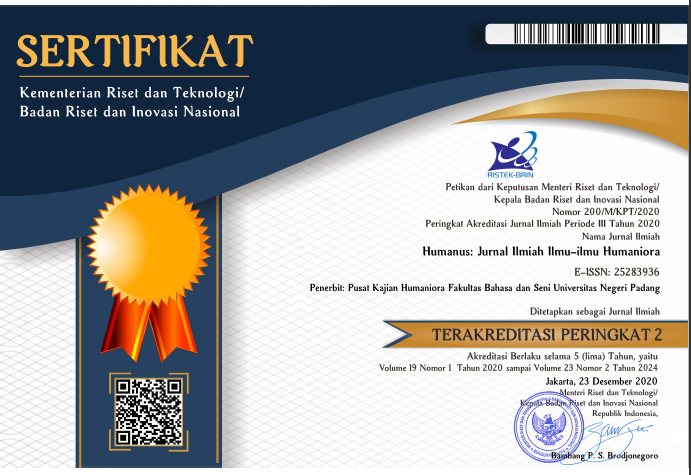Revealing the Linguistic Features Used in Mantra Pengasihan (The Spell of Affection) in Banyuwangi
 ), Wisasongko Wisasongko(2), Imam Basuki(3),
), Wisasongko Wisasongko(2), Imam Basuki(3), (1) Universitas Jember
(2) Universitas Jember
(3) Universitas Jember
 Corresponding Author
Corresponding Author
Copyright (c) 2020 Humanus
DOI : https://doi.org/10.24036/humanus.v19i2.109117
Full Text:
 Language : en
Language : en
Abstract
As a country with full of cultural diversity, Indonesia has various cultures comprising knowledge, belief, art, law, moral, custom, and habit possessed by human as a member of a community. One of the cultural forms in Indonesia is mantra which is still maintained up to the current time and is still practiced by the community in many different places for many different purposes. One of the existing mantras is mantra pengasihan (the spell of affection). The aim of this study is to reveal the role of linguistic features used in mantra pengasihan (MP), especially Sabuk Mangir. The data were collected by deeply interviewing some Subjects (shamans/dukun/pawang or the mantra spellers) and the Object (the target persons) in Glagah and Licin Subdistricts, Banyuwangi. Having been collected, the data were analyzed by content analysis approach to find the types of languages, the narrative elements, the sentence patterns, and the figurative languages used in MP. This research reveals that mostly MP uses (Osing) Javanese and Arabic language, employs opening, main part, and closing elements to express the magic power, chooses declarative and imperative moods to state the physical description of the speller, and the request to the supernatural power, and uses some figurative languages (metaphors, simile, and repetition) to motivate and generate the magical power.
Keywords: dukun, magi, mantra, magical power, Osing,
Keywords
References
Badaruddin, M.S. (2018). ‘Linguistic features depicted in Tulembang mantra’ in The 1st Annual International Conference on Language and Literature (AICLL), KnE Social Sciences, Sciences, pgs: 609 – 622.
Butts, D., Fahe, R., Spinks, S, and Yellop, C. (1993). Using Functional Grammar: An Explorer’s Guide. Macquarie: National Center for English Language Teaching and Research. Macquarie University.
Daud, H. (2010). ‘Oral traditions in Malaysia: a discussion of shamanism’ in Jurnal Wacana, Vol. 12 (1): 181–200.
Halliday, MAK. and Hasan, R. (1989). Language, context, and text: Aspects of language in a social-semiotic perspective. Victoria: Deakin University Press.
Herniti, E. (2012). ‘Kepercayaan masyarakat Jawa terhadap santet, mistik, dan roh menurut perspetif Edwards Evans-Pritchard’ in Thaqãfiyyãt Vol. 13(2): 384-400.
Jannah, N.I. & Jurinani, E. (2017). “Pewarisan ilmu dukun dalam sistem penyembuhan tradisional” (Shamanic power inheritance in traditional healing system) in Masyarakat, Kebudayaan dan Politik, Vol. 30(1): 48-58.
Lakoff, G.D. and Johnson, M. (2003). Metaphors We Live by. Chicago: University of Chicago.
Masruri, A. (2010). The Secret of Santet. Jakarta: Visimedia.
Moreno, M.A. (2008). Metaphors in Hugo Chavez’s political discourse: conceptualizing nation, revolution, and opposition. PhD Dissertation: The City University of New York.
Sahad, M.N. (2015). ‘Penggunaan azimat pelaris perniagaan menurut perspektif akidah Islam’ (The Use of Business Lures from the Islamic Perspective), in Jurnal Antarabangsa Dunia Melayu, Vol. 8(1): 18-44.
Saputra, H SP, (2001). ‘Tradisi mantra kelompok etnik Using di Banyuwangi’ in Jurnal Humaniora, Vol. 13(3): 260 - 267.
Saputra, H SP, (2007). Memuja Mantra: Sabuk Mangir dan Jaran Goyang Masyarakat Suku Using Banyuwangi. Yogyakarta: Penerbit LkiS Yogyakarta.
Syarifuddin, (2008). ‘Mantra nelayan Bajo di Sumbawa: tinjauan bentuk dan isi (makna)’ in Jurnal Humaniora, 20 (1): 102-115.
 Article Metrics
Article Metrics
 Abstract Views : 621 times
Abstract Views : 621 times
 PDF Downloaded : 171 times
PDF Downloaded : 171 times
Refbacks
- There are currently no refbacks.
Copyright (c) 2020 Humanus

This work is licensed under a Creative Commons Attribution-NonCommercial 4.0 International License.










